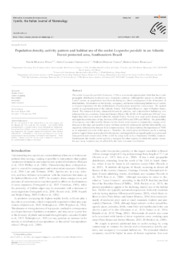Population density, activity pattern and habitat use of the ocelot Leopardus pardalis in an Atlantic Forest protected area, Southeastern Brazil.
Population density, activity pattern and habitat use of the ocelot Leopardus pardalis in an Atlantic Forest protected area, Southeastern Brazil.
Author(s): WOLFF, N. M.; FERREGUETTI, A. C.; TOMAS, W. M.; BERGALLO, H. G.
Summary: The ocelot Leopardus pardalis (Linnaeus, 1758) is a nocturnal opportunistic felid that has a wide geographic distribution in almost every American continent. Although this species is classified as Least Concern, its populations have been declining as a direct consequence of the destruction of their habitats. Information on the density, occupancy and factors influencing habitat use of ocelots is of great importance for the establishment of action plans aimed for conservation. We studied ocelots in a protected area of the Atlantic Forest, Vale Natural Reserve, state of Espírito Santo, Brazil. We estimated density, characterized activity patterns, and evaluated how habitat use was influenced by six covariates. Estimated density (MeanSE; 45.845.45 ocelots per 100 km2) was higher than other areas studied within the Atlantic Forest. Ocelots were more active during twilight and night than other times of day (between 1330 and 2030 h and 2330 and 0400 h). The probability of occupancy was influenced by distance to the closest water resources (negatively), canopy cover, distance to the edge and number of prey (all three positively influenced), and the detectability was negatively influenced by distance from a water resource. Our data reinforce the importance of VNR as an important reservoir of the species. Therefore, the results presented herein can be a starting point to support future action plans for the species, making predictions regarding the ecosystem and management and conservation of the ocelot by using tools such as Population Viability Analysis. Furthermore, the results can be used as a surrogate for other regions in which the species occurs, because many locations may be affected by the same covariates used herein.
Publication year: 2019
Types of publication: Journal article
Unit: Embrapa Pantanal
Observation
Some of Embrapa's publications are published as ePub files. To read them, use or download one of the following free software options to your computer or mobile device. Android: Google Play Books; IOS: iBooks; Windows and Linux: Calibre.
Access other publications
Access the Agricultural Research Database (BDPA) to consult Embrapa's full library collection and records.
Visit Embrapa Bookstore to purchase books and other publications sold by Embrapa.

